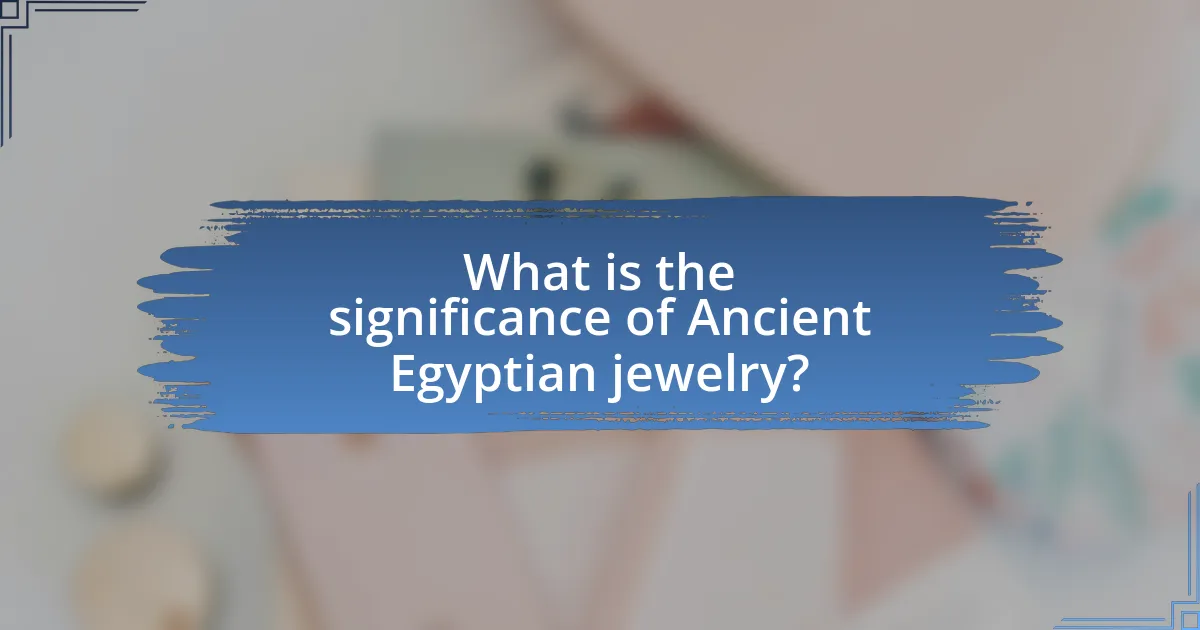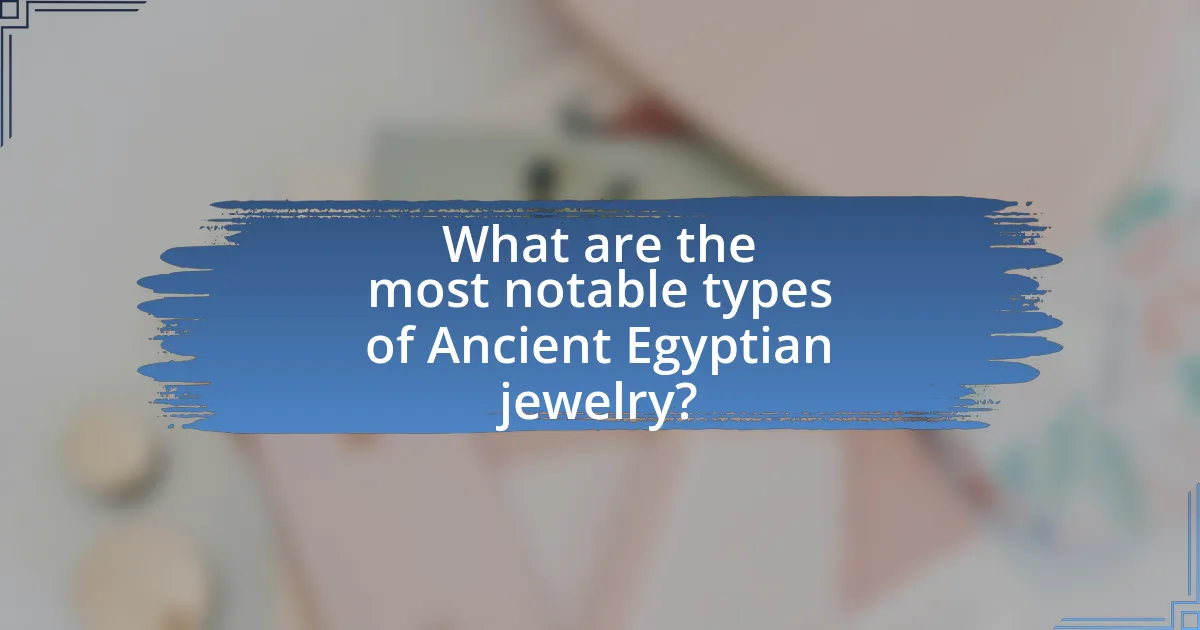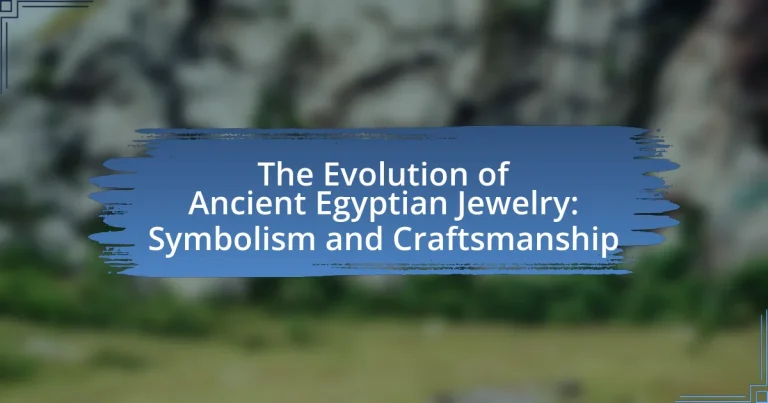The article focuses on the evolution of Ancient Egyptian jewelry, emphasizing its symbolism and craftsmanship throughout various historical periods. It explores the cultural and religious significance of jewelry, detailing how materials like gold, silver, and semi-precious stones were used to reflect social status and power. The piece also examines the intricate designs and techniques employed by artisans, such as granulation and cloisonné, and highlights the prevalent symbols, including the ankh and scarab, that conveyed deeper meanings related to life, protection, and the afterlife. Additionally, the article discusses the influence of foreign cultures on Egyptian craftsmanship and offers insights into modern practices inspired by Ancient Egyptian jewelry design.

What is the significance of Ancient Egyptian jewelry?
Ancient Egyptian jewelry holds significant cultural and religious importance, serving as symbols of status, protection, and spirituality. Jewelry was often crafted from gold, silver, and precious stones, reflecting the wealth and power of the wearer, particularly among pharaohs and nobility. Additionally, pieces such as amulets were believed to provide protection in the afterlife, as evidenced by the burial artifacts found in tombs, which included intricate jewelry designed to accompany the deceased. The craftsmanship of Ancient Egyptian jewelry also showcases advanced techniques, such as granulation and cloisonné, highlighting the civilization’s artistic and technological achievements.
How did Ancient Egyptian jewelry reflect social status?
Ancient Egyptian jewelry reflected social status through the materials used, the complexity of designs, and the symbolism embedded in the pieces. High-ranking individuals, such as pharaohs and nobles, wore jewelry made from precious metals like gold and adorned with gemstones, which signified wealth and power. For example, the use of lapis lazuli, turquoise, and carnelian in jewelry was exclusive to the elite, as these materials were rare and expensive. Additionally, intricate designs often featured motifs associated with divinity and protection, such as the ankh and scarab, further emphasizing the wearer’s elevated status. The presence of specific symbols and the quality of craftsmanship in jewelry pieces served as visual indicators of an individual’s rank within Ancient Egyptian society.
What materials were commonly used in Ancient Egyptian jewelry?
Ancient Egyptian jewelry commonly utilized materials such as gold, silver, semi-precious stones, and glass. Gold was highly prized for its luster and durability, often symbolizing wealth and divinity, while silver was less common but valued for its beauty. Semi-precious stones like lapis lazuli, turquoise, and carnelian were frequently incorporated for their vibrant colors and believed protective properties. Additionally, glass was used to create beads and decorative elements, showcasing the advanced craftsmanship of the period. These materials reflect the cultural significance and artistic sophistication of Ancient Egyptian jewelry.
How did the design of jewelry indicate wealth and power?
The design of jewelry in ancient Egypt indicated wealth and power through the use of precious materials, intricate craftsmanship, and symbolic motifs. Wealthy individuals adorned themselves with gold, silver, and gemstones, which were not only valuable but also rare, signifying their high social status. For example, the use of gold in jewelry was prevalent among pharaohs and nobility, as it was associated with the divine and eternal life. Additionally, the complexity of the designs, such as those featuring hieroglyphs or depictions of gods, reflected the owner’s sophistication and connection to the spiritual realm. Historical evidence shows that tombs of elite individuals were filled with elaborate jewelry, underscoring its role as a status symbol in ancient Egyptian society.
What role did symbolism play in Ancient Egyptian jewelry?
Symbolism played a crucial role in Ancient Egyptian jewelry by conveying religious beliefs, social status, and protection. Jewelry often featured symbols such as the ankh, representing life, and the scarab, symbolizing rebirth and protection in the afterlife. These symbols were not merely decorative; they were believed to hold magical properties that could safeguard the wearer and ensure favor from the gods. For instance, gold was associated with the divine and immortality, making it a preferred material for jewelry worn by pharaohs and deities. The use of specific gemstones also carried symbolic meanings; lapis lazuli was linked to the heavens, while turquoise represented fertility and rebirth. Thus, the intricate designs and materials used in Ancient Egyptian jewelry were deeply embedded with symbolism that reflected the culture’s values and beliefs.
Which symbols were most prevalent in Ancient Egyptian jewelry?
The most prevalent symbols in Ancient Egyptian jewelry included the ankh, scarab, and the Eye of Horus. The ankh symbolized life and immortality, often seen in amulets and pendants. The scarab represented rebirth and protection, frequently used in rings and brooches. The Eye of Horus, associated with protection and royal power, was commonly featured in various jewelry pieces. These symbols were integral to the cultural and spiritual beliefs of Ancient Egyptians, reflecting their values and practices in craftsmanship.
How did these symbols convey religious beliefs?
Symbols in ancient Egyptian jewelry conveyed religious beliefs by representing deities, the afterlife, and protection. For instance, the ankh symbol, which resembles a cross with a loop, signified eternal life and was often worn by the living and placed in tombs to ensure a safe passage to the afterlife. Additionally, the scarab beetle symbolized resurrection and transformation, reflecting the belief in rebirth. Jewelry adorned with these symbols served not only as adornment but also as a means to invoke divine favor and protection, as evidenced by archaeological findings that show such pieces were commonly included in burial artifacts to accompany the deceased in their journey to the afterlife.

How did craftsmanship evolve in Ancient Egyptian jewelry making?
Craftsmanship in Ancient Egyptian jewelry making evolved significantly from the Predynastic period through the Greco-Roman era. Initially, artisans utilized simple techniques and materials, such as bone and shells, to create basic adornments. As time progressed, particularly during the Old Kingdom (c. 2686–2181 BCE), the introduction of gold and semi-precious stones marked a shift towards more intricate designs and advanced techniques, including granulation and cloisonné.
By the New Kingdom (c. 1550–1070 BCE), craftsmanship reached its zenith, characterized by highly skilled artisans who employed sophisticated methods like filigree and stone inlay, resulting in elaborate pieces that reflected the wealth and status of their wearers. The use of symbolism in jewelry, such as the scarab and the ankh, further enhanced the cultural significance of these items, intertwining artistry with religious and social meanings. This evolution showcases the transition from utilitarian objects to complex works of art that played a crucial role in Ancient Egyptian society.
What techniques were used by Ancient Egyptian jewelers?
Ancient Egyptian jewelers employed techniques such as granulation, cloisonné, and inlay to create intricate jewelry pieces. Granulation involved fusing tiny metal balls onto a surface to form decorative patterns, while cloisonné utilized thin metal strips to create compartments filled with colored glass or gemstones. Inlay techniques allowed jewelers to set stones or other materials into metal surfaces, enhancing the visual appeal of their creations. These methods were documented in ancient texts and artifacts, showcasing the advanced craftsmanship and artistic skills of Ancient Egyptian jewelers.
How did the tools and methods change over time?
The tools and methods used in the creation of ancient Egyptian jewelry evolved significantly from the Predynastic period through the Greco-Roman era. Initially, artisans relied on simple hand tools made from stone and bone, which limited their ability to create intricate designs. By the Middle Kingdom, advancements included the introduction of metalworking techniques, such as casting and soldering, which allowed for more complex and durable pieces.
During the New Kingdom, the use of gold and precious stones became prevalent, and techniques like granulation and filigree emerged, showcasing a high level of craftsmanship. The introduction of specialized tools, such as the bow drill and chisels, further enhanced the precision and detail in jewelry making. By the time of the Greco-Roman period, the incorporation of foreign influences led to new styles and methods, including the use of enameling and more sophisticated stone-setting techniques, reflecting a blend of cultural artistry.
What were the influences of foreign cultures on Egyptian craftsmanship?
Foreign cultures significantly influenced Egyptian craftsmanship, particularly through trade and conquest. The introduction of materials such as lapis lazuli from Afghanistan and carnelian from India enriched the palette available to Egyptian artisans. Additionally, the artistic styles and techniques from neighboring regions, including Nubia and the Levant, led to the incorporation of new motifs and designs in jewelry and decorative arts. For instance, the use of intricate filigree and granulation techniques, which were prevalent in Minoan and Mycenaean cultures, can be observed in later Egyptian jewelry pieces. This blending of styles not only enhanced the aesthetic appeal of Egyptian craftsmanship but also reflected the cultural exchanges that occurred over centuries, as evidenced by archaeological findings in tombs and temples.
What were the major periods of evolution in Ancient Egyptian jewelry?
The major periods of evolution in Ancient Egyptian jewelry include the Pre-Dynastic Period, the Old Kingdom, the Middle Kingdom, the New Kingdom, and the Late Period. During the Pre-Dynastic Period (circa 4000-3100 BCE), jewelry was primarily made from natural materials like shells and stones, reflecting early craftsmanship. The Old Kingdom (circa 2686-2181 BCE) saw the introduction of gold and more intricate designs, symbolizing wealth and power, particularly in royal burials. In the Middle Kingdom (circa 2055-1650 BCE), jewelry became more accessible to the middle class, featuring more diverse materials and styles. The New Kingdom (circa 1550-1070 BCE) marked the peak of jewelry artistry, with elaborate pieces adorned with precious stones and intricate symbolism related to the afterlife. Finally, the Late Period (circa 664-332 BCE) experienced a revival of earlier styles, influenced by foreign cultures, while still maintaining traditional Egyptian motifs. Each period reflects the evolving social, religious, and artistic values of Ancient Egyptian society.
How did the Middle Kingdom differ from the New Kingdom in jewelry design?
The Middle Kingdom differed from the New Kingdom in jewelry design primarily through the complexity and symbolism of the pieces. During the Middle Kingdom, jewelry was characterized by simpler designs and a focus on utilitarian function, often featuring materials like gold, silver, and semi-precious stones in more modest arrangements. In contrast, the New Kingdom saw a significant evolution towards elaborate and intricate designs, with a greater emphasis on symbolism and the use of a wider variety of materials, including colored glass and faience, to create more visually striking pieces. This shift is evidenced by the ornate jewelry found in royal tombs from the New Kingdom, such as the burial treasures of Tutankhamun, which showcase advanced techniques and a rich iconography that reflected the era’s wealth and religious beliefs.
What innovations emerged during the Late Period of Ancient Egypt?
During the Late Period of Ancient Egypt, significant innovations in jewelry design and craftsmanship emerged, characterized by the use of new materials and techniques. Jewelers began incorporating semi-precious stones like turquoise, carnelian, and lapis lazuli, enhancing the aesthetic appeal and symbolic significance of jewelry. Additionally, advancements in metalworking allowed for more intricate designs, including the use of filigree and granulation techniques, which added texture and detail to pieces. These innovations reflected the cultural influences of foreign interactions and the evolving artistic expressions of the time, as evidenced by the discovery of elaborate jewelry in tombs from this period, showcasing both craftsmanship and the importance of jewelry in burial practices.

What are the most notable types of Ancient Egyptian jewelry?
The most notable types of Ancient Egyptian jewelry include necklaces, bracelets, earrings, rings, and anklets. These pieces were often made from gold, silver, and semi-precious stones, reflecting the wealth and status of the wearer. Necklaces, such as the broad collar, were adorned with colorful beads and amulets, symbolizing protection and prosperity. Bracelets and anklets frequently featured intricate designs and were believed to ward off evil spirits. Earrings varied in style, often showcasing elaborate designs that highlighted the craftsmanship of the artisans. Rings, commonly engraved with hieroglyphs or symbols, served both decorative and functional purposes, such as signet rings used for sealing documents. The craftsmanship of Ancient Egyptian jewelry was highly advanced, with techniques like granulation and inlay being employed to create intricate patterns and designs, demonstrating the civilization’s artistic and technological prowess.
What were the common types of jewelry worn by Ancient Egyptians?
Ancient Egyptians commonly wore jewelry such as necklaces, bracelets, earrings, and rings. These pieces were often made from materials like gold, silver, and semi-precious stones, reflecting their wealth and status. For instance, gold was favored for its durability and association with the divine, while lapis lazuli and turquoise were used for their vibrant colors and believed protective properties. Additionally, jewelry often featured symbolic motifs, such as scarabs and ankhs, which represented rebirth and life, respectively. The prevalence of these jewelry types is well-documented in archaeological findings, including tomb artifacts and ancient texts, illustrating their significance in Ancient Egyptian culture.
How did amulets serve a protective purpose in jewelry?
Amulets served a protective purpose in jewelry by being believed to possess magical properties that warded off evil and misfortune. In ancient Egyptian culture, these small objects were often inscribed with symbols or deities, such as the Eye of Horus, which was thought to provide protection and health. Historical evidence shows that amulets were commonly buried with the deceased to ensure safety in the afterlife, reflecting their significance in both daily life and spiritual beliefs.
What was the significance of necklaces and bracelets in Ancient Egypt?
Necklaces and bracelets in Ancient Egypt held significant cultural and symbolic value, serving as indicators of social status, religious beliefs, and personal identity. These adornments were often made from precious materials like gold, lapis lazuli, and carnelian, reflecting the wealth and power of the wearer. Additionally, they were imbued with protective and magical properties, as many pieces featured amulets or symbols associated with deities, such as the ankh or scarab, believed to provide safety in the afterlife. The craftsmanship involved in creating these items also demonstrated the advanced skills of Egyptian artisans, highlighting the importance of jewelry in both daily life and ceremonial practices.
How can we appreciate Ancient Egyptian jewelry today?
We can appreciate Ancient Egyptian jewelry today by studying its intricate designs, symbolic meanings, and the craftsmanship that reflects the culture and beliefs of the time. The jewelry often featured materials such as gold, lapis lazuli, and carnelian, which were not only valued for their beauty but also for their significance in ancient Egyptian society, representing wealth, power, and protection. For instance, the use of scarabs and other motifs in jewelry served as amulets believed to provide spiritual protection. Museums and exhibitions showcasing these artifacts allow contemporary audiences to engage with the historical context and artistry, enhancing our understanding of their cultural importance.
What modern practices can be inspired by Ancient Egyptian jewelry craftsmanship?
Modern practices that can be inspired by Ancient Egyptian jewelry craftsmanship include the use of intricate beadwork, the incorporation of symbolic motifs, and the application of goldsmithing techniques. Ancient Egyptians utilized detailed beadwork to create visually stunning pieces, which can inspire contemporary jewelry designers to explore complex patterns and textures in their work. Additionally, the symbolism found in Ancient Egyptian jewelry, such as the ankh and scarab, can inform modern designs by embedding deeper meanings into contemporary pieces. Furthermore, the advanced goldsmithing techniques employed by Ancient Egyptian artisans, including granulation and cloisonné, can be adapted by modern jewelers to enhance the quality and aesthetic appeal of their creations. These practices highlight the enduring influence of Ancient Egyptian craftsmanship on today’s jewelry design.
How can one incorporate Ancient Egyptian symbolism into contemporary jewelry design?
One can incorporate Ancient Egyptian symbolism into contemporary jewelry design by utilizing iconic motifs such as the ankh, scarab, and Eye of Horus. These symbols carry rich meanings; for instance, the ankh represents life and immortality, the scarab symbolizes rebirth and protection, and the Eye of Horus signifies health and prosperity. Designers can integrate these elements through engraving, casting, or using colored gemstones that reflect the vibrant palette of Ancient Egyptian art. Historical context supports this approach, as Ancient Egyptians often used jewelry not only for adornment but also as amulets for spiritual protection, which can be mirrored in modern designs that aim to convey similar protective or meaningful attributes.
What are some tips for collecting or studying Ancient Egyptian jewelry?
To effectively collect or study Ancient Egyptian jewelry, one should focus on understanding the historical context, craftsmanship techniques, and materials used. Researching the significance of symbols, such as the ankh or scarab, is crucial as these motifs often convey deeper meanings related to life, death, and protection in Ancient Egyptian culture. Additionally, examining the craftsmanship, including techniques like granulation and inlay, provides insight into the skill level of artisans during that period. Authenticity is paramount; therefore, acquiring pieces from reputable dealers or auction houses, and verifying provenance through documentation or expert appraisal, ensures the integrity of the collection. Engaging with academic resources, such as museum catalogs or scholarly articles, enhances knowledge and appreciation of the artistry involved in Ancient Egyptian jewelry.


